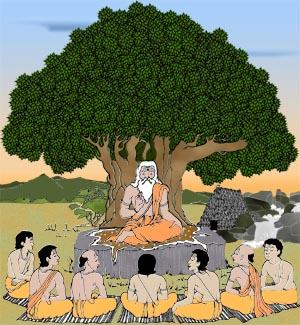 Ram Rajya
Ram Rajya
Bhagwan Ram, Sita and Lakshman were spending their days in exile in the forests. Sita was abducted by Ravan. While Ravan was on his way to Lanka, Sita threw some of her jewellery as a lead on Mt. Rushayamoonk. Sugreeva found it and kept it with him. In their search for Sita, both Ram and Lakshman came to the mountain. Sugreeva, on their enquiry, brought Sita's jewellery and narrated what he had seen. Bhagwan Ram gave the jewellery to Lakshman to see if he could recognise it to be Sita's. Lakshman failed to identify Sita's earnings and a necklace but when he saw her anklet he burst out enthusiastically, "This is mother Sita's anklet."
Ram asked him why he hadn't recognised Sita's ear-rings ('kundal') and bracelet ('keyur'). In reply Lakshman answered,
Nãham jãnãmi keyuram, nãham jãnãmi kundalam,
Nupuram eva jãnãmi, nityam pãdãbhivandanãt.
"I have never seen mother Sita's ear-rings and her bracelet but while touching the dust of her holy feet everyday I had noticed these anklets."
For 14 long testing years when only three individuals lived and moved together in the forests, we find Lakshman serving both his brother and wife Sita with unswerving discipline. The epic Ramyan eloquently drives home a lesson of respect bordered with discipline. Lakshman attributes his nobility by saying,
Pitã yasya shuchimurto mãtã yasya pativratã,
Ubhãbhyãmeva sambhrutaha tasya no chalate manah.
"One's mind is never soiled by evil thoughts when one is born of pure noble parents."
Bharat bitterly refused the kingship acquired by his mother at the cost of Ram's exile. He lived a hermit's life during the entire 14 years. Sita went through the furnace of fiery trials – Ram having banished her – yet she entertained no ill feeling for Ram. On the contrary, like a flower that still offers fragrance when crushed, Sita said,
Bhuyo yathã me janannãnterapi,
Tvamev bhartã na cha viprayogaha.
"Oh Ram, may you be my husband birth after birth."
The famous poet Kalidas describes the 'Raghu' clan as, "The descendants of the Raghu clan were noble and pure from birth." The Ram Rajya was indeed a noble empire established by luminous souls.
India's Glorious Society
The power of Sati Savitri's fidelity for her husband, Satyavan, brought him back to existence from the death noose of Yamraja. Nachiketa, the shining star of India's youths, remained resolute in acquiring the eternal knowledge and thus denied the pleasure of wealth and women offered by Yamraja.
Shravan's loving service to his aged parents, King Harishchandra's unparalleled sacrifice for truth, King Rantidev's charity of food after a spartan 49 day fast, the humility of King Ambarish and the valorous Arjun who saved himself from the infatuation of Urvashi's charms by calling her 'mother' are just a few of many fragrant flowers that have bloomed on the turf of Indian Society.
The distinguished economist Nani Palkhiwala, with respect to Vedic Society says, "Citizens were ranked in the society not by wealth or power but by the virtue and character they possessed."
"Is this Man?"
On the sands of time, the element of negligence has painted an ugly picture on our noble structure of character. Today we find theology has lost its appeal and technology has taken the lead. Metaphysics has been stripped of its prefix and now mere physics remains. Human values have degraded to alarming levels.
Alvin Toffler, author of 'The Third Wave', points out that after the Agricultural Revolution, the 17th century saw the birth of a second wave beginning with the Industrial Revolution. The second wave has left our society in a medley of mounting problems. We now live in a diseased society suffering from the virus of hatred, social tensions, corruption, crippling strikes and union agitation, energy crises, pollution, unemployment, loneliness, frustration... The list is endless.
On August 6th, 1945 man dropped the devastating atomic bomb on his own kind. It was the day when he relinquished his humanity and raised a cloud of doubt, "Is this man?"
Translated by Sadhu Vivekjivandas